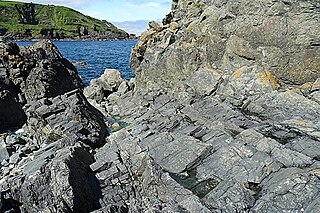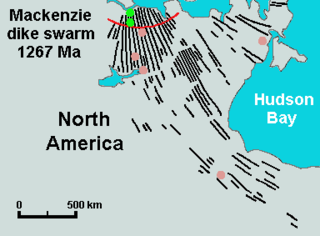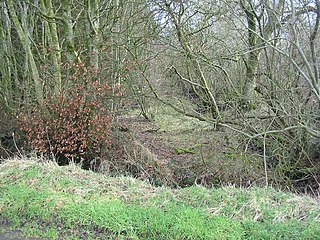
A levee, dike, dyke, embankment, floodbank, or stop bank is a structure that is usually earthen and that often runs parallel to the course of a river in its floodplain or along low-lying coastlines. The purpose of a levee is to keep the course of rivers from changing and to protect against flooding of the area adjoining the river or coast. Levees can be naturally occurring ridge structures that form next to the bank of a river, or be an artificially constructed fill or wall that regulates water levels. Ancient civilizations in the Indus Valley, ancient Egypt, Mesopotamia and China all built levees. Today, levees can be found around the world, and failures of levees due to erosion or other causes can be major disasters.

A ditch is a small to moderate divot created to channel water. A ditch can be used for drainage, to drain water from low-lying areas, alongside roadways or fields, or to channel water from a more distant source for plant irrigation. Ditches are commonly seen around farmland, especially in areas that have required drainage, such as The Fens in eastern England and much of the Netherlands.
Dyke (UK) or dike (US) may refer to:

A dike or dyke, in geological usage, is a sheet of rock that is formed in a fracture of a pre-existing rock body. Dikes can be either magmatic or sedimentary in origin. Magmatic dikes form when magma flows into a crack then solidifies as a sheet intrusion, either cutting across layers of rock or through a contiguous mass of rock. Clastic dikes are formed when sediment fills a pre-existing crack.

The Car Dyke was, and to a large extent still is, an 85-mile (137 km) long ditch which runs along the western edge of the Fens in eastern England. It is generally accepted as being of Roman age and, for many centuries, to have been taken as marking the western edge of the Fens. There, the consensus begins to break down.
Dykes is a British surname which is thought to originate from the hamlet of Dykesfield in Burgh-by-Sands, Cumbria in the north of England. Due to its close proximity to the English and Scottish borders, the surname Dykes has also been found in Scottish lowlands throughout the ages. The first family to bear the surname are said to have lived in the area prior to William the Conqueror's Norman conquest of England, with the oldest surviving written document placing them in Dykesfield at the end of the reign of Henry III. The family took their surname from Hadrian's Wall, also referred to in some texts as Hadrian's Dyke. The great wall crossed Great Britain from the mouth of the Tyne to the Solway Firth and forms part of the border for Dykesfield.
Diagonal pliers are pliers intended for the cutting of wire. The plane defined by the cutting edges of the jaws intersects the joint rivet at an angle or "on a diagonal", hence the name.
Dyck is a form of the Dutch surname (van) Dijck, which is also common among Russian Mennonites.

A sheeted dyke complex, or sheeted dike complex, is a series of sub-parallel intrusions of igneous rock, forming a layer within the oceanic crust. At mid-ocean ridges, dykes are formed when magma beneath areas of tectonic plate divergence travels through a fracture in the earlier formed oceanic crust, feeding the lavas above and cooling below the seafloor forming upright columns of igneous rock. Magma continues to cool, as the existing seafloor moves away from the area of divergence, and additional magma is intruded and cools. In some tectonic settings slices of the oceanic crust are obducted (emplaced) upon continental crust, forming an ophiolite.

The Mackenzie dike swarm, also called the Mackenzie dikes, forms a large igneous province in the western Canadian Shield of Canada. It is part of the larger Mackenzie Large Igneous Province and is one of more than three dozen dike swarms in various parts of the Canadian Shield.

The Scots' Dike or dyke is a three and a half mile / 5.25 km long linear earthwork, constructed by the English and the Scots in the year 1552 to mark the division of the Debatable lands and thereby settle the exact boundary between the Kingdom of Scotland and the Kingdom of England.
Van Dyck or Vandyck is a Dutch toponymic surname meaning "from (the) dike", originally written Van Dijck. Notable people with the surname include:
Van Dyk or Vandyk is an Afrikaans toponymic meaning "from (the) dike". It can also be directly derived from the Dutch form Van Dijk.
The Czech surname Dyk has a patronymic origin in the given name Benedikt.
People with these names include:

A dike swarm or dyke swarm is a large geological structure consisting of a major group of parallel, linear, or radially oriented magmatic dikes intruded within continental crust or central volcanoes in rift zones. Examples exist in Iceland and near other large volcanoes, around the world. They consist of several to hundreds of dikes emplaced more or less contemporaneously during a single intrusive event, are magmatic and stratigraphic, and may form a large igneous province.

The term dyke is a slang term, used as a noun meaning lesbian and as an adjective describing things associated with lesbians. It originated as a homophobic slur for masculine, butch, or androgynous girls or women. Pejorative use of the word still exists, but the term dyke has been reappropriated by many lesbians to imply assertiveness and toughness.
Robert or Bob Sykes may refer to:
Scot's Dike or Scot's Dyke may refer to:
This page is based on this
Wikipedia article Text is available under the
CC BY-SA 4.0 license; additional terms may apply.
Images, videos and audio are available under their respective licenses.








